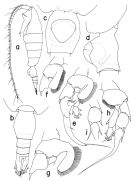|
|
 |
|
Calanoida ( Order ) |
|
|
|
Arietelloidea ( Superfamily ) |
|
|
|
Heterorhabdidae ( Family ) |
|
|
|
Heterorhabdus ( Genus ) |
|
|
| |
Heterorhabdus cohibilis Park, 2000 (F,M) | |
| | | | | | | Ref.: | | | Park, 2000 (p.128, figs.F,M, Rem.) |  issued from : T. Park in Bull. Scripps Inst. Oceanogr. Univ. California, San Diego, 2000, 31. [p.251, Fig.99]. Female: a, habitus (left side); b, urosome (dorsal); c, d, genital somite (ventral, left, respectively). Nota female: - Cephalosome 45 % length of prosome. - Prosome 71 % length of body and about 2.4 times length of urosome. - Posterolateral corner of prosome rounded, overlapping anterior 1/10 length of genital somite. - Urosome 29 % length of body. - Length ratios of 4 urosomal somites and left caudal ramus 37.7 : 18.8 : 14.1 : 8.8 : 20.6 = 100. - Dorsally, genital somite widest at middle, slightly asymmetrical, with a broadly curved right margin and a slightly sigmond left margin. - Anteriorly, caudal ramus with 2 pores. Dorsal appendicular seta of left caudal ramus about 1.5 times length of that of right ramus. - A1 extending beyond posterior end of caudal ramus by its last 2 segments. - All cephalosomal appendages and swimming legs similar to those of H. americanus. Male: e, right P5 (anterior); f, g, basipod of right P5 (anterior, tilted clockwise, respectively); h, left P5 (anterior); i, exopod of left P5 (anterior). Nota male: - Prosome 73 % length of body and about 2.6 times length of urosome. - Urosome 28 % length of body. - Caudal rami and setation as in female. - Left geniculate A1 similar to that of H. spinifrons- All other cephalosomal appendages and P1-P4 as in female.
|
 Heterorhabdus cohibilis Heterorhabdus cohibilis female: 1 - See key to species groups of Heterorhabdus: ''abyssalis'' Group (p.90, 114). 2 - Genital somite without a conical projection mediodorsally (Fig.99- a, d). 3 - Laterally, genital somite without a tubercular outgrowth posteriorly on dorsal margin (Fig.99-a). 4 - Laterally, genital operculum far short of reaching posterior end of somite (Fig.99-c). 5 - Laterally, right and left genital flanges symmetrical. 6 - Laterally, genital prominence distinctly separate from ventral wall of somite (Fig.99-d). 7 - Dorsally, as well as ventrally, lateral swellings of genital somite reaching posterior end of somite (Fig.99-b). 8 - Laterally, genital prominence far short of extending to posterior end of somite; genital somite with a low dorsal hump. 9 - Laterally, genital operculum far short of reaching posterior end of genital prominence (Fig.99-d).
|
 Heterorhabdus cohibilis Heterorhabdus cohibilis male: 1 - See key to species groups of Heterorhabdus: ''abyssalis'' Group (p.90, 114). 2 - Basis of left P5 without a well-developed inner lobe (Fig.99-h). 3 - Basal inner lobe of right P5 armed with normal bristles (Fig.99-e, g). 4 - 3rd exopodal segment of right P5 with a short terminal lobe, less than 1/3 length of terminal spine (Fig.99-e). 5 - Basal lobe of right P5 arising from anteromedial side of segment (Fig.99-e). 6 - 2nd exopodal segment of left P5 with outer spine not borne on a conical process (Fig.99-h). 7 - 3rd exopodal segment of right P5 with terminal spine longer than 1/2 length of segment (Fig.99-e). 8 - Anteriorly and when tilted clockwise, basal lobe of right P5 recurved by folding. 9 - Anteriorly, basal lobe of right P5 slightly folded (Fig.98-e). 10 - Basal lobe of right P5 not conspicuously inflated distally (Fig.99-g).
| | | | | NZ: | 3 | | |
|
Distribution map of Heterorhabdus cohibilis by geographical zones
|
| | | | | | | Loc: | | | E Pacif. (equatorial), Salomon Is., Indonesia (Banda Sea), China Seas (East China Sea)
Type locality: 0°55' N, 112°50' W.
For Park (2000, p.129), the species is taken in the eastern equatorial Pacific between 00°55' S and 02°35' N and between 112°57' W and 112°36' W; in the western equatorial Pacific at 09°25' S, 159°06' E; in the Malay Archipelago at 04°40' S, 125°33' E; in the East China Sea at 25°35' N, 124°30' E. | | | | N: | 1 | | | | Lg.: | | | (824) F: 3,6-2,8; M: 3,32-2,68; {F: 2,80-3,60; M: 2,68-3,32} | | | | Rem.: | "Abyssalis" Group.
For Park (2000, p.129) this species is very close to H. americanus but can be distinguished from it in the female by the relatively short genital operculum, which in lateral view is far short of reaching the posterior edge of the genital flange, while the genital operculum in H. americanus is extending to the posterior edge of the genital flange. The male can be identified by the basal inner lobe of the right P5.. Furthermore, the two species have different ranges: H. cohibilis occurs widely in the equatorial Pacific indcluding the Malay Archipelago, while H. americanus was found only in coastal waters of the eastern tropical Pacific.. | | | Last update : 17/10/2017 | |
|
|
 Any use of this site for a publication will be mentioned with the following reference : Any use of this site for a publication will be mentioned with the following reference :
Razouls C., Desreumaux N., Kouwenberg J. and de Bovée F., 2005-2025. - Biodiversity of Marine Planktonic Copepods (morphology, geographical distribution and biological data). Sorbonne University, CNRS. Available at http://copepodes.obs-banyuls.fr/en [Accessed December 29, 2025] © copyright 2005-2025 Sorbonne University, CNRS
|
|
 |
 |




